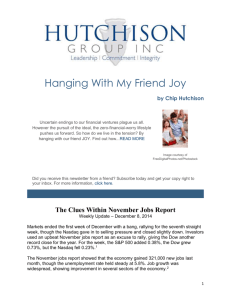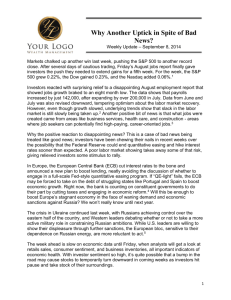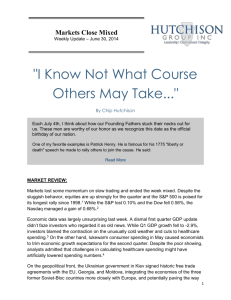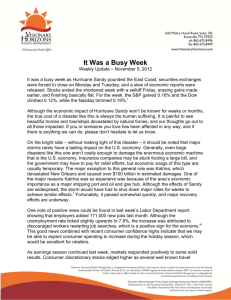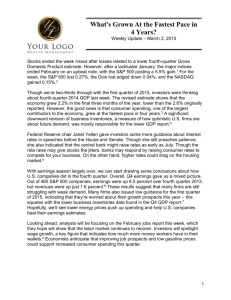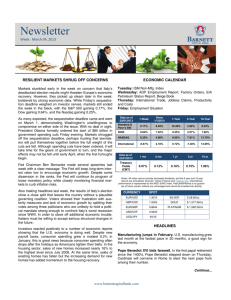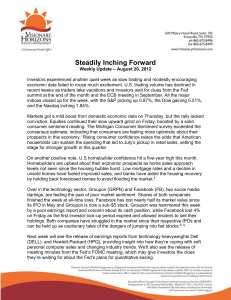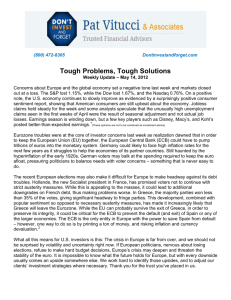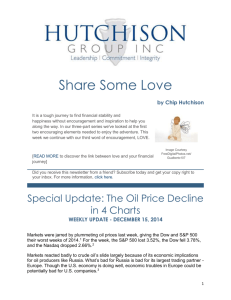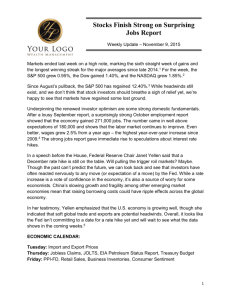2014-06-24 Weekly Financial Navigator
advertisement
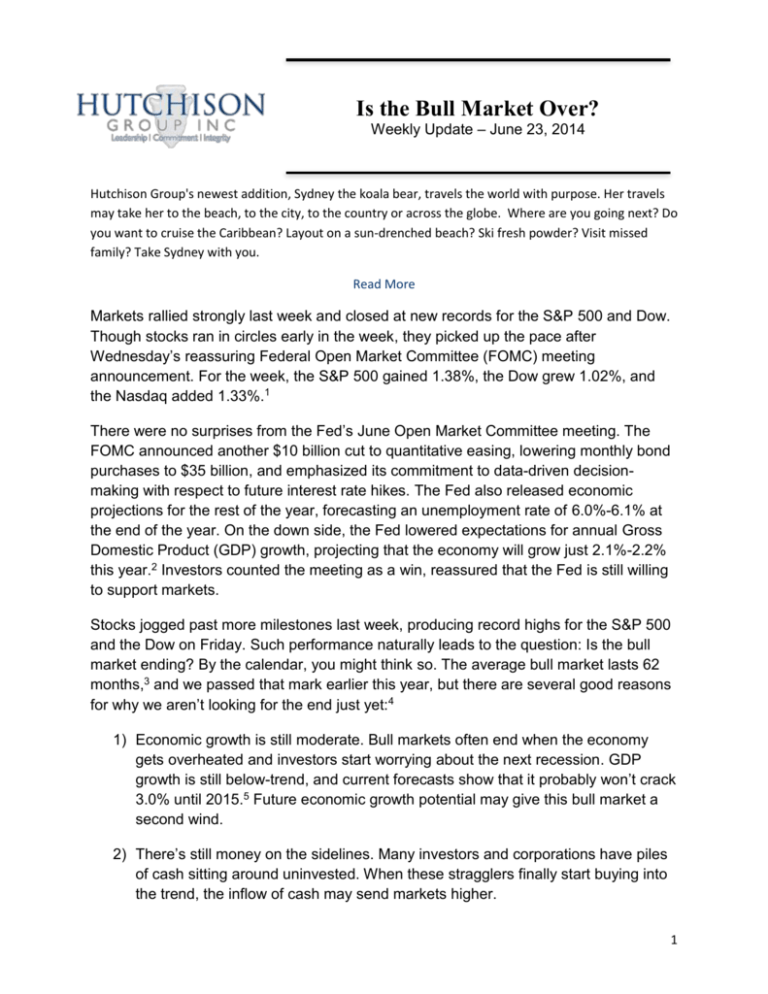
Is the Bull Market Over? Weekly Update – June 23, 2014 Hutchison Group's newest addition, Sydney the koala bear, travels the world with purpose. Her travels may take her to the beach, to the city, to the country or across the globe. Where are you going next? Do you want to cruise the Caribbean? Layout on a sun-drenched beach? Ski fresh powder? Visit missed family? Take Sydney with you. Read More Markets rallied strongly last week and closed at new records for the S&P 500 and Dow. Though stocks ran in circles early in the week, they picked up the pace after Wednesday’s reassuring Federal Open Market Committee (FOMC) meeting announcement. For the week, the S&P 500 gained 1.38%, the Dow grew 1.02%, and the Nasdaq added 1.33%.1 There were no surprises from the Fed’s June Open Market Committee meeting. The FOMC announced another $10 billion cut to quantitative easing, lowering monthly bond purchases to $35 billion, and emphasized its commitment to data-driven decisionmaking with respect to future interest rate hikes. The Fed also released economic projections for the rest of the year, forecasting an unemployment rate of 6.0%-6.1% at the end of the year. On the down side, the Fed lowered expectations for annual Gross Domestic Product (GDP) growth, projecting that the economy will grow just 2.1%-2.2% this year.2 Investors counted the meeting as a win, reassured that the Fed is still willing to support markets. Stocks jogged past more milestones last week, producing record highs for the S&P 500 and the Dow on Friday. Such performance naturally leads to the question: Is the bull market ending? By the calendar, you might think so. The average bull market lasts 62 months,3 and we passed that mark earlier this year, but there are several good reasons for why we aren’t looking for the end just yet:4 1) Economic growth is still moderate. Bull markets often end when the economy gets overheated and investors start worrying about the next recession. GDP growth is still below-trend, and current forecasts show that it probably won’t crack 3.0% until 2015.5 Future economic growth potential may give this bull market a second wind. 2) There’s still money on the sidelines. Many investors and corporations have piles of cash sitting around uninvested. When these stragglers finally start buying into the trend, the inflow of cash may send markets higher. 1 3) Plenty of bull markets last longer than 62 months. The one between 1987 and 2000 lasted roughly 150 months, and the rally between 1949 and 1956 lasted about 87 months.6 Now, we can’t assume that markets will continue their upward progress indefinitely. As we discovered in the first few months of the year, declines do happen. One of the benefits of an active management strategy is that we can use these interruptions in the overall trend to cherry pick solid investments at attractive prices. Overall, we’re still cautiously optimistic about market performance going into the latter half of the year. We’ll know more about future prospects as Q2 economic data and earnings reports trickle in over the coming weeks. ECONOMIC CALENDAR: Monday: PMI Manufacturing Index Flash, Existing Home Sales Tuesday: S&P Case-Shiller HPI, New Home Sales, Consumer Confidence Wednesday: Durable Goods Orders, GDP, EIA Petroleum Status Report Thursday: Jobless Claims, Personal Income and Outlays Friday: Consumer Sentiment Data as of 6/20/2014 1-Week Since 1/1/14 1-Year 5-Year 10-Year Standard & Poor’s 500 1.38% 6.20% 23.59% 22.61% 7.29% Dow 1.02% 2.23% 14.83% 19.69% 6.27% NASDAQ 1.33% 4.58% 29.82% 27.80% 11.99% U.S. Corporate Bond Index -0.07% 2.96% 3.25% 3.57% 1.31% International 1.19% 5.14% 22.16% 14.03% 8.63% Data as 6/20/2014 1 mo. 6 mo. 1 yr. 5 yr. 10 yr. Treasury Yields (CMT) 0.01% 0.04% 0.09% 1.71% 2.63% Notes: All index returns exclude reinvested dividends, and the 5-year and 10-year returns are annualized. Sources: Yahoo! Finance and Treasury.gov. International performance is represented by the MSCI EAFE Index. Corporate bond performance is represented by the DJCBP. Past performance is no guarantee of future results. Indices are unmanaged and cannot be invested into directly. HEADLINES: U.S. exports slump. America’s current account deficit – the difference between imports and exports – widened in the first quarter largely because the cold weather caused exports to pile up in port. Hopefully, stronger overseas demand will cause exports to pick up in the second quarter.7 Weekly jobless claims fall. The number of Americans filing new claims for unemployment benefits fell more than expected last week, suggesting that labor market conditions continue to improve.8 2 U.S. manufacturing production rises. Factory production rose significantly in May, supporting the belief that the sector is rebounding strongly after the first quarter slowdown. Since manufacturing contributes 12.5% to GDP growth, we can hope for a strong showing this quarter.9 Oil prices rise on Iraq fears. The price of Brent crude oil rose above $113/barrel as the fighting in Iraq intensified and shut down the country’s biggest refinery. Though exports have not yet been affected, it’s likely that prices will continue to be affected as investors respond to disruption fears.10 “The most common way people give up their power is by thinking they don’t have any.” –Alice Walker Lobster Rolls with Corn and Celery Enjoy this twist on a New England summer favorite. Ingredients: Serves 4 4 cooked lobster tails (about 1 1/2 pounds total), cooled 2 tablespoons unsalted butter, at room temperature 3 1 cup fresh corn (from 1 ear) 2 stalks celery, diced 1/3 cup mayonnaise 1 tablespoon fresh lemon juice Kosher salt and black pepper 4 potato buns split Directions: 1. Using kitchen shears, cut through underside of each lobster tail, splitting them in half and pulling apart to expose the meat. Remove the meat and chop coarsely. Transfer it to a large bowl. 2. Melt 1-2 tablespoons of butter in a heavy-bottomed skillet over medium heat. Add the fresh corn and cook 2 to 4 minutes until tender. Add it to the bowl. 3. Mix the lobster and corn with celery, mayonnaise, and lemon juice. Toss to combine the ingredients. Add salt and pepper to taste. 4. Spread each potato bun with butter and toast until golden. 5. Fill each bun with lobster salad. Recipe adapted from Charlyne Mattox | RealSimple.com Get an IRS Notice? Don’t Panic. The IRS sends millions of notices to taxpayers each year for a variety of reasons. Here are a few things you should know if you receive a notice in the mail: Don’t panic. Most notices are benign and are about a specific issue on your tax return. Read the instructions in the notice carefully to know what to do. Often, simply responding to the notice will take care of the problem. If you don’t agree with the findings of the notice, it’s very important that you respond as soon as possible. Include any documentation that supports your side and mail it to the IRS with the bottom tear-off portion of the notice. Keep copies of any notices you receive and your response with the relevant tax return. If you have questions about how to handle an IRS notice, contact your tax advisor or call the IRS at the number included with the notice. 4 The IRS will never contact you by email, phone, or social media. Any request you receive for personal or financial information over those channels is a scam and should be ignored or forwarded to phishing@irs.gov. Tip courtesy of IRS.gov11 Stop Shanking Golfers often shank with their wedges because of the open clubface and steep path of the swing needed to use the club properly. The technique increases the risk that you will hit the ball with the hosel – the part of the club where the shaft is secured. To avoid shanking, let your arms hang down naturally from your shoulders and hinge at the hips, pushing your rear backwards and giving yourself space between arms and body. If you pull your hips and rear in when swinging, you’ll bring the hosel too close to the ball, risking a shank. Tip courtesy of Steve Atherton, GolfTEC | Golf Tips Mag12 Use Organic Ketchup to Get More Lycopene Lycopene, a nutrient with important disease-fighting properties, is found in tomatoes and tomato-derived foods. Researchers from the USDA compared lycopene levels in over a dozen ketchup brands and found that organic ketchup contains as much as three times the amount of the antioxidant as nonorganic brands. Although there are no concrete recommendations on daily lycopene dosage, eating a lycopene-rich diet has been shown to be beneficial to long-term health. Tip courtesy of AARP13 Trim Your Kitchen Waste 5 The average American household creates about 1.28 pounds of trash every day and tosses about 14% of their food purchases. If you think you throw away too much food, follow these easy steps to reduce waste: Watch your kitchen trash. Monitor what you throw away for a few weeks and take notes on what common items end up in the trash. Stale cereal? Week-old leftovers? Use this information to change your buying and cooking habits. Reorganize your fridge so that perishables stay front and center. This will help you remember what you have on hand when prepping meals. Serve smaller portions. If you notice that you or your family often throws away food after meals, consider serving smaller portion sizes. Plan weekly clean-out meals. Use one meal per week to use up produce, fruit, and other perishables. Casseroles, smoothies, frittatas, and pasta dishes are all great ways to use up produce on its last legs. Though bruised or imperfect fruits and vegetables are still edible, it’s best to throw away any moldy items. Tip courtesy of Whole Living14 Share the Wealth of Knowledge! Please share this market update with family, friends, or colleagues. If you would like us to add them to our list, simply click on the "Forward email" link below. We love being introduced! If you would like to opt-out of future emails, please reply to this email with UNSUBSCRIBE in the subject line. Insert your broker/dealer disclosures here. i.e. Securities offered through “Your B/D Name Here,” Member FINRA/SIPC. Investing involves risk including the potential loss of principal. No investment strategy can guarantee a profit or protect against loss in periods of declining values. Diversification does not guarantee profit nor is it guaranteed to protect assets The Standard & Poor's 500 (S&P 500) is an unmanaged group of securities considered to be representative of the stock market in general. The Dow Jones Industrial Average is a price-weighted average of 30 significant stocks traded on the New York Stock Exchange and the NASDAQ. The DJIA was invented by Charles Dow back in 1896. The Nasdaq Composite is an index of the common stocks and similar securities listed on the NASDAQ stock market and is considered a broad indicator of the performance of stocks of technology companies and growth companies. The MSCI EAFE Index was created by Morgan Stanley Capital International (MSCI) that serves as a benchmark of the performance in major international equity markets as represented by 21 major MSCI indexes from Europe, Australia and Southeast Asia. The Dow Jones Corporate Bond Index is a 96-bond index designed to represent the market performance, on a total-return basis, of investment-grade bonds issued by leading U.S. companies. Bonds are equally weighted by maturity cell, industry sector, and the overall index. The S&P/Case-Shiller Home Price Indices are the leading measures of U.S. residential real estate prices, tracking changes in the value of residential real estate. The index is made up of measures of real estate prices in 20 cities and weighted to produce the index. 6 The 10-year Treasury Note represents debt owed by the United States Treasury to the public. Since the U.S. Government is seen as a risk-free borrower, investors use the 10-year Treasury Note as a benchmark for the long-term bond market. Google Finance is the source for any reference to the performance of an index between two specific periods. Opinions expressed are subject to change without notice and are not intended as investment advice or to predict future performance. Past performance does not guarantee future results. You cannot invest directly in an index. Consult your financial professional before making any investment decision. Fixed income investments are subject to various risks including changes in interest rates, credit quality, inflation risk, market valuations, prepayments, corporate events, tax ramifications and other factors. These are the views of Platinum Advisor Marketing Strategies, LLC, and not necessarily those of the named representative, Broker dealer or Investment Advisor, and should not be construed as investment advice. Neither the named representative nor the named Broker dealer or Investment Advisor gives tax or legal advice. All information is believed to be from reliable sources; however, we make no representation as to its completeness or accuracy. Please consult your financial advisor for further information. By clicking on these links, you will leave our server, as they are located on another server. We have not independently verified the information available through this link. The link is provided to you as a matter of interest. Please click on the links below to leave and proceed to the selected site. 1 http://goo.gl/UVAvcx 2 http://wsj-us.econoday.com/byshoweventfull.asp?fid=464104&cust=wsj-us&year=2014&lid=0&prev=/byweek.asp#top 3 http://www.zacks.com/stock/news/125505/What-Comes-Next-as-the-Bull-Market-Turns-Five 4 Hat tip to Steve Reitmeister 5 http://wsj-us.econoday.com/byshoweventfull.asp?fid=464104&cust=wsj-us&year=2014&lid=0&prev=/byweek.asp#top 6 http://www.bespokeinvest.com/thinkbig/2014/3/4/longest-and-strongest-bull-markets-updated.html 7 http://www.cnbc.com/id/101769170 8 http://www.cnbc.com/id/101772587 9 http://www.nam.org/Statistics-And-Data/Facts-About-Manufacturing/Landing.aspx , http://www.cnbc.com/id/101762241 10 http://www.cnbc.com/id/101768270 11 http://www.irs.gov/uac/Newsroom/Ten-Things-to-Know-about-IRS-Notices-and-Letters 12 http://www.golftipsmag.com/instruction/iron-play/quick-tips/stop-shanking.html#.U6Y5-I1dVsI 13 http://www.aarp.org/health/healthy-living/info-2014/health-boosters-take-minute-photo.html#slide8 14 http://www.wholeliving.com/136597/12-ways-prevent-food-waste-home/@center/136755/green-home-guide#47458 7
